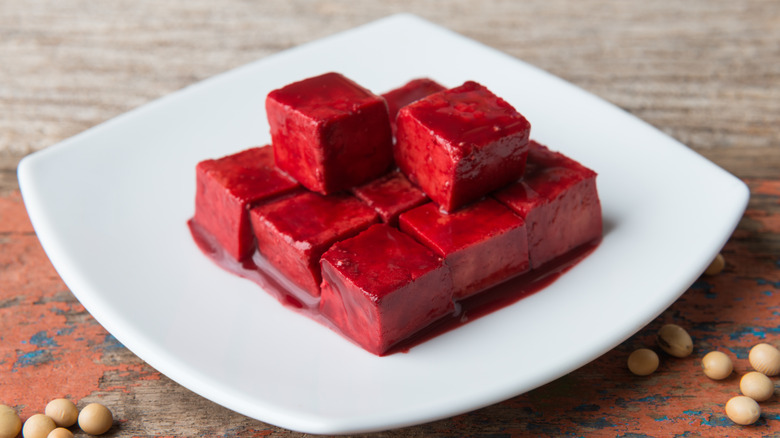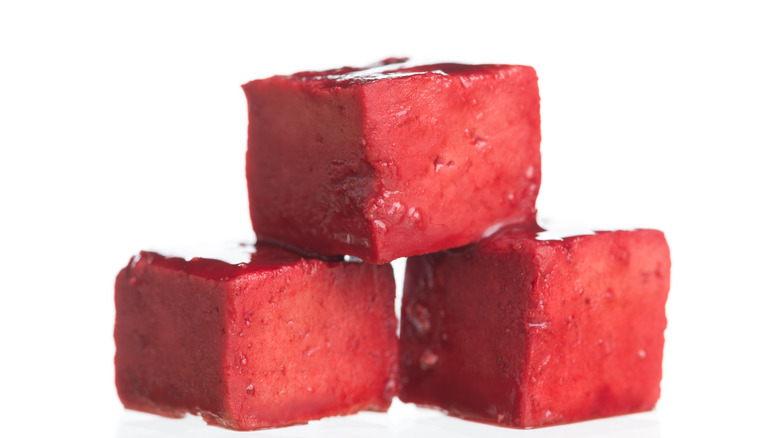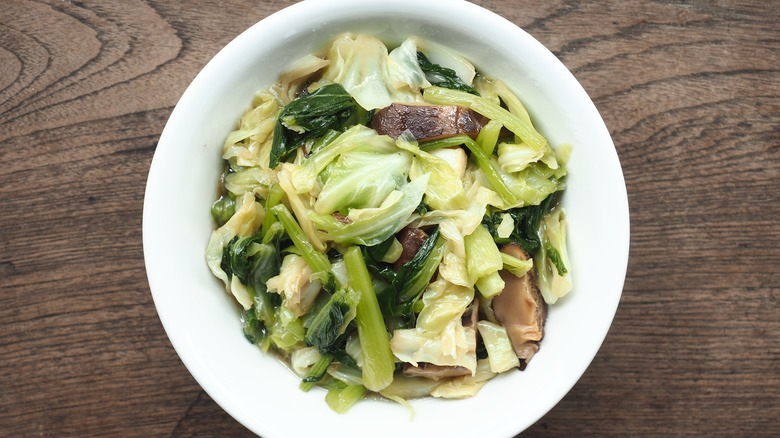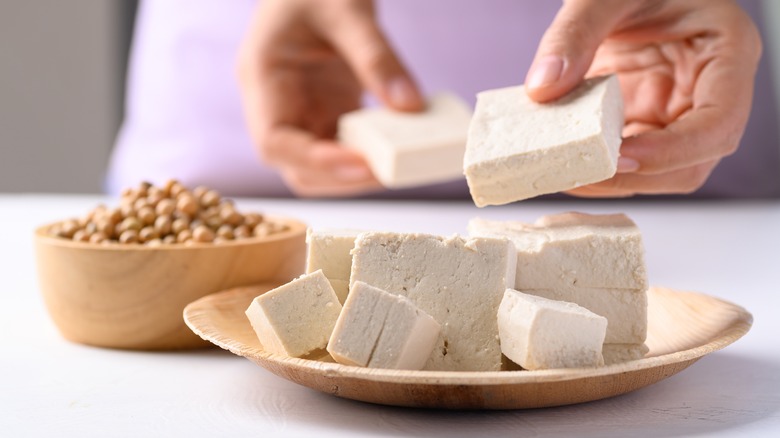What Is Furu And How Do You Cook With It?
We may receive a commission on purchases made from links.
Fermented foods are all the rage — and for a good reason. Highly beneficial for gut health, their probiotic-dense qualities are in need now more than ever. As a result of the extensive use of antibiotics, popularity of processed foods, and improved hygiene, American stomachs are changing — and could use a microbial boost, reports Harvard Health. Asian cuisine is an excellent choice for incorporating fermented products. From fermented bean pastes in China, fish sauces in Southeast Asia, and kimchi in Korea, there are many ingredients to choose from. Not only do these products boast unique salty and spicy flavor profiles, they are also naturally umami-rich, notes a 2015 study in the Critical Reviews in Food Science and Nutrition.
For a fermented Asian food full of flavor, turn to furu. A pickled tofu commonly eaten in China and Vietnam, its texture and flavor are reminiscent of blue cheese, yet the food is completely vegan, per Wandering Chopsticks. Eaten simply with rice, or as a component in sauces, it carries a lot of culinary uses, so let's open a jar and dive in.
What is furu?
Furu is a preserved tofu product, made by pickling fresh curds in a salty, vinegary brine with flavorings, per The Woks of Life. Typically exported to the U.S. in jars, it's most commonly found in a classic, as well as red variety, which is made with a particular kind of molded rice. Production recipes are kept secret, with some distributors including rice wine or baiju (sorghum grain liquor) in the mix. For the most densely flavored, umami-rich furu variety, go for the red version.
Furu tastes predominantly salty, with a hint of sweetness and a varying degree of fermented funk. Its texture is soft, almost cheese-like, with a consistency easily broken down with chopsticks. Although unrelated to soy milk, such a dairy-like texture has lent it the name soy bean cheese, via everything2. Its pickling liquid is aromatic and thick, perfect as a base for sauces. Flavored versions, especially with spicy chilies, are common — so double-check the label before purchasing.
How is furu made?
Furu is made by cubing tofu into wooden boxes and allowing it to mold for five days at a controlled temperature, via Shine. Next, the tofu is covered and salt is spread between each cube layer. Such a process inhibits microbial growth; the tofu loses water and develops a thick exterior crust. The final step infuses flavor — the soybean product is covered in a brine, which contains a combination of spices, chilies, alcohol, sugar, and salt. The creation is found ubiquitously in China, including in grocery stores, markets, and home kitchens.
Variations in furu depend on the type of fermentation, differences in processing, and the base ingredients. Many deviations occur — the brined tofu spends up to three months in fermentation, typically in a jar covered in paper. There's often regional affiliation with treatment techniques, explains China Food Ingredients. Such a range of processing also means a variety of culinary applications — let's dive into how to cook with furu.
How to cook with furu
A blue cheese-esque tofu, furu's strong flavor easily overpowers palates — less is more when it comes to culinary applications. Most commonly, this fermented food is added in small quantities to congee, a savory rice porridge, according to Food & Wine. It works wonders when cooking leafy vegetables, its umami-rich essence transforming anything from spinach to swiss chard to kale. While braising these greens, Food & Wine recommends adding a little furu into the dish during cooking for an easy-to-make, yet rich sauce.
Furu's umami-dense essence equally benefits marinades. According to Serious Eats, it's added to dynamic applications like fried chicken brines, ceviche-like shrimp denaturation, and even salad dressings. Once the flavor becomes more familiar, you can simply smear some onto a freshly steamed bun.
While still less popularized than other Asian fermented foodstuffs, furu is receiving more attention in U.S restaurants. Acclaimed San Francisco chef Brandon Jew blends furu with sea urchins and tendrils, while Lucas Sin of New Haven's Junzi Kitchen serves a furu sesame sauce alongside noodles and salads, notes The New York Times Style Magazine. Furu is ripe for experimentation — once comfortable with its funkiness, the sky's the limit for its applications.
Health benefits of furu
Consumed in China since as early as the second century, furu is a staple food with important health properties. Like cheese, the fermented substance contains proteins and fats altered by bacteria, making it easier to digest, as noted in "Modernization of Traditional Food Processes and Products" via ResearchGate. Tofu already contains high protein content, as well as Vitamin A, per Healthline. When brined during furu production, its nutritional properties are strengthened further — especially in calcium content.
Furu also presents more anti-oxidant and anti-mutagenic (mutation-lessening) properties than raw tofu. Intensified in red furu, which also contains rice mold, these effects are attributed to properties of the bacterial fermentation, and not the soybean base, per "Food Chemistry" by way of ScienceDirect.
Furu stores for months, and its powerful bacterial effects do not lessen with time. Research demonstrates its fermented activity is nearly the same after three months of aging. Additionally, no need to worry about spoilage — harmful microorganisms aren't part of the mix, per a 2000 study in Critical Reviews in Biotechnology. Such a sustained benefit makes it an ideal ingredient to keep on hand. Unopened, these jars store for years and after use, will keep in the fridge for months, says Serious Eats. Umami and nutritionally rich, a spoonful in a sauce will do wonders.
Where to buy furu
Due to its stable shelf-life, furu is easy to procure online. You can find it on Amazon, but there are also specialty online Asian grocers like Yami that carry it. When you search for it online, Serious Eats recommends using the keywords "fermented bean curd" or "Chinese cheese." In addition, it's a staple of Chinese and Taiwanese groceries, available from small convenience shops to larger supermarkets like 99 Ranch and H Mart.
Furu is typically sold in jars in the pickled food section, according to Serious Eats. There's nothing to look for specifically when buying furu — try several brands to find one for the designated culinary uses. Many favor the umami-rich red furu for sauces, while the white is more accessible to consumer on its own, notes The Woks of Life. After growing accustomed to this fermented product, it'll surely become a pantry staple. Toss it into a variety of dishes for an umami-rich, protein hit — there's nothing else quite like it.





